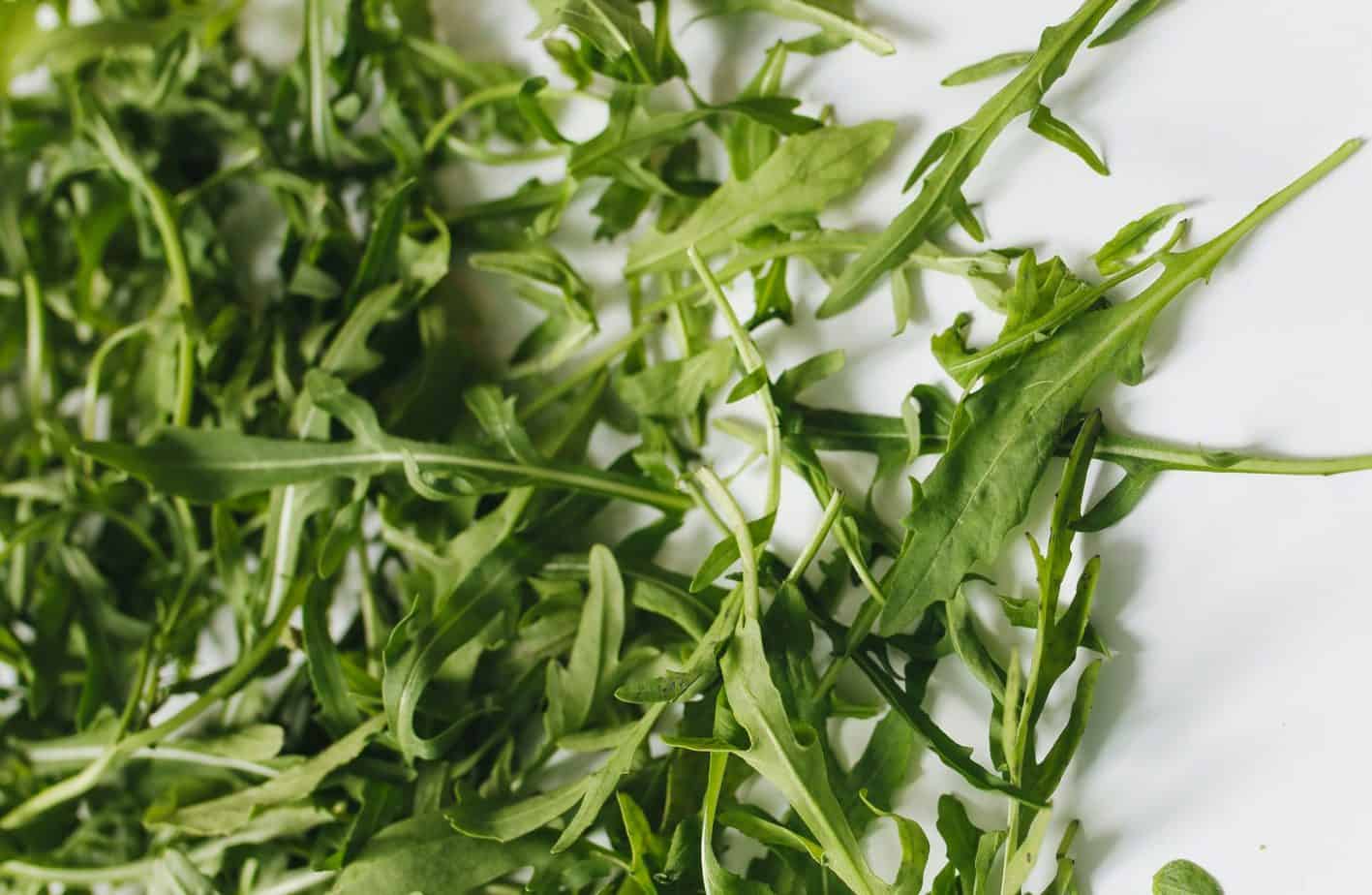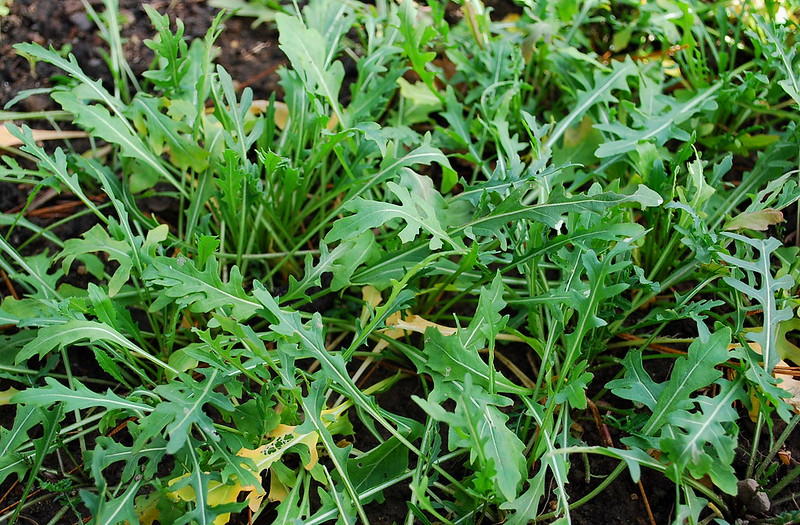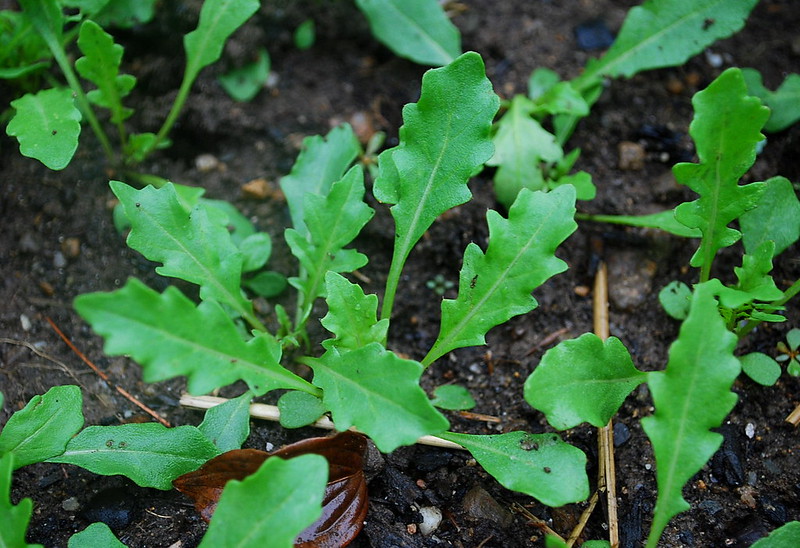Arugula, also known as rocket or roquette, is a cool weather leafy green vegetable that has been grown for its mustard-like peppery kick since the Romans.
It’s also really easy to grow, but is best planted in early spring or late summer. Arugula will quickly bolt in hot weather, which causes it to produce a flower stalk. This, however, also makes the leaves turn hairy and taste bitter. Fortunately, there are some arugula varieties that take longer to bolt and can even still taste palatable after bolting.
In general, wild arugula cultivars perform much better in the heat compared to standard garden arugula varieties.
| Arugula Variety | Heat Tolerance | Flavor Intensity | Days to Maturity |
|---|---|---|---|
| Astro | 6/10 | Mild | 30 to 40 days |
| Slow Bolt | 7/10 | Moderate | 40 to 45 days |
| Wild Arugula | 8/10 | Moderate to Strong | 50 days |
| Bellezia (Wild-type) | 7.5/10 | Mild to Moderate | 50 days |
| Wildfire (Wild-type) | 7.5/10 | Moderate to Strong | 45 days |
On this page:
Heat Tolerant Arugula Varieties
Astro Arugula
Fast-growing, moderate heat-tolerant variety
Days to Maturity: 30 to 40 days
Heat Tolerance: 6/10
Flavor Intensity: Mild
Open Pollinated? Yes
Get seeds: Johnny’s Selected Seeds (US), Harris Seeds (US), Fedco Seeds (US), High Mowing Organic Seeds (US), West Coast Seeds (Canada), Veseys (Canada), William Dam Seeds (Canada), Johnsons (UK)
A rapidly maturing arugula, Astro is one of the most productive heat-tolerant varieties you can grow despite looking like regular salad arugula. Astro can be harvested as baby arugula in as little as 21 days, but to harvest large, lobed leaves it can take anywhere from 30 to 40 days. Astro arugula is also perfect for micro-greens.
Astro has a milder taste than other arugula varieties but like all arugula, gets spicier as the weather warms up. Good heat tolerance and thrives in cold temperatures as well.
Slow Bolt Arugula
A variety that can add a few more weeks of spring harvests
Days to Maturity: 40 to 45 days
Heat Tolerance: 7/10
Flavor Intensity: Moderate
Open Pollinated? Yes
Get seeds: MIGardener (US), Sow True Seed (US), True Leaf Market (US), Hometown Seeds (US), Dollar Seed (US)
Slow Bolt is another broad-leafed, lobed arugula that was specifically bred to resist bolting, and can add a few more weeks of harvests compared to non-tolerant varieties. Very similar to Astro, the main differences are slightly better heat resistance and a spicier, more peppery taste.
Harvest baby greens in as little as 30 days, and full-sized leaves in around 40 days. This is the recommended variety for those who specifically want a heat tolerant salad arugula.
Wild Arugula (Diplotaxis tenuifolia)
A wild cousin of standard salad arugula that bolts slowly and still tastes great when it does
Days to Maturity: 50 days
Heat Tolerance: 8/10
Flavor Intensity: Moderate to Strong
Open Pollinated? Yes
Get seeds: Baker Creek (US), Johnny’s Selected Seeds (US), Hudson Valley Seed (US), West Coast Seeds (Canada), McKenzie Seeds (Canada)
Wild-type arugula varieties are renowned for their spicy kick but are also some of the hardiest, most heat-tolerant types of arugula you can grow. Wild arugula tends to have smaller, serrated leaves, and its flowers are yellow (like mustard) instead of white.
While wild arugula is among the most bolt-resistant, heat tolerant arugula, it will still eventually bolt. However, even after bolting, wild arugula leaves don’t turn bitter, but will get spicier. The flowers are perfectly edible as well.
In areas with mild winters, wild arugula is actually a perennial. In the garden, wild arugula grows like a weedy rosette, then after bolting it produces long branches with loads of thin leaves.
The main drawback is that wild arugula germinates and grows more slowly than regular arugula varieties. You may need to wait 50 days to harvest mature leaves, but baby greens can sometimes be ready in 40 days.
Bellezia Arugula (Diplotaxis tenuifolia)
A tamed wild arugula for market growers and home gardeners
Days to Maturity: 50 days
Heat Tolerance: 7.5/10
Flavor Intensity: Mild to Moderate
Open Pollinated? Yes
Get seeds: Johnny’s Selected Seeds (US), Harris Seeds (US), Territorial Seeds (US), High Mowing Organic Seeds (US), West Coast Seeds (Canada), William Dam Seeds (Canada)

Bellezia is a wild-type heirloom cultivar selected for market growers, so it has a excellent uniformity while still preserving its heat tolerance and is very slow to bolt.
Another benefit of growing Bellezia is it has a milder, almost nutty taste, with classic peppery arugula notes in the background.
Wildfire Arugula (Diplotaxis tenuifolia)
A wild-type cultivar whose distinctive flavor, leaf shapes, and time to maturity give the best of both worlds
Days to Maturity: 45 days
Heat Tolerance: 7.5/10
Flavor Intensity: Moderate
Open Pollinated? Yes
Get seeds: Jung Seed (US), West Coast Seeds (Canada), William Dam Seeds (Canada), Thompson & Morgan (UK)
Gardeners on the fence of whether to grow standard garden arugula varieties or wild varieties can find both benefits in Wildfire arugula. It’s leaves are less serrated than other wild varieties and are less uniform, making them great for arugula salads or salad mixes. It also has a slightly shorter maturity time, which gives it an edge against other wild cultivars.
Flavor-wise, Wildfire has that same peppery kick but is balanced with a slight sweetness when you first bite into it, making it a really unique addition to the salad garden.
Because it is still technically a wild-type arugula, Wildfire has excellent heat tolerance, and since Wildfire germinates and grows more quickly, it’s also more suitable for micro-greens.
Understanding the Difference: Regular Arugula vs. Wild Arugula
Arugula comes in many different varieties, but there are in fact two completely different species of plants which are known as arugula, although they are both in the same family as brassicas like mustard. There’s the standard garden arugula, classified as either Eruca sativa or Eruca vesicaria and then there is wild arugula, which is Diplotaxis tenuifolia. They are essentially grown the same way, with a few key differences.
Garden Arugula (Eruca sativa / Eruca vesicaria)
Regular arugula, sometimes called garden arugula, is an annual plant that is grown for it’s peppery leaves. Regular arugula leaves are usually large and lobed. The flavor can vary from mild to quite spicy, but are generally milder than wild arugula varieties. After bolting, the leaves get spicier, much more bitter, and will grow hairs along the stem and petioles. The flowers are white and are also edible.
Wild Arugula (Diplotaxis tenuifolia)
Wild arugula is a perennial weed that evolved to have the same peppery taste as garden arugula, but are usually spicier. Wild arugula tends to have more serrated or oak-shaped leaves, and the leaves themselves are often, but not always, smaller. After bolting, wild arugula leaves get smaller, spicier, but not as bitter as regular arugula. Wild arugula has excellent heat tolerance and puts out yellow flowers, which are also edible.
Which Is Better: Wild Arugula or Regular Arugula?
Arugula lovers should grow both, but each have their advantages. Wild arugula has much better heat tolerance overall and still tastes good (but spicier) after bolting. Regular arugula tends to grow faster, with larger leaves, and tastes milder, which means you can get larger harvests in a shorter amount of time.
Tips on How to Grow Arugula in the Summer
Even heat tolerant arugula varieties are not immune to bolting – all arugula will eventually bolt. However, heat tolerant cultivars will buy you more time to get more harvests before the leaves turn too bitter.
Just as with other cool weather leafy greens, there are ways to extend your arugula growing season into summer.
If possible, plant your arugula in partial shade, which will reduce the heat. For example, planting along an east-facing or west-facing fence will block sunlight for part of the day. You can also grow it as an “understory” underneath larger plants like tomatoes or even trees.
Another option is to plant arugula in containers, which will allow you to move it to shadier places during really hot, summer days.
Lastly, as an option for those who live consistently hot southern climates, you can use shade cloth to cover your arugula. Shade cloth blocks a certain percentage of sunlight (30-50% is recommended) which will keep your arugula cool and delay bolting.




